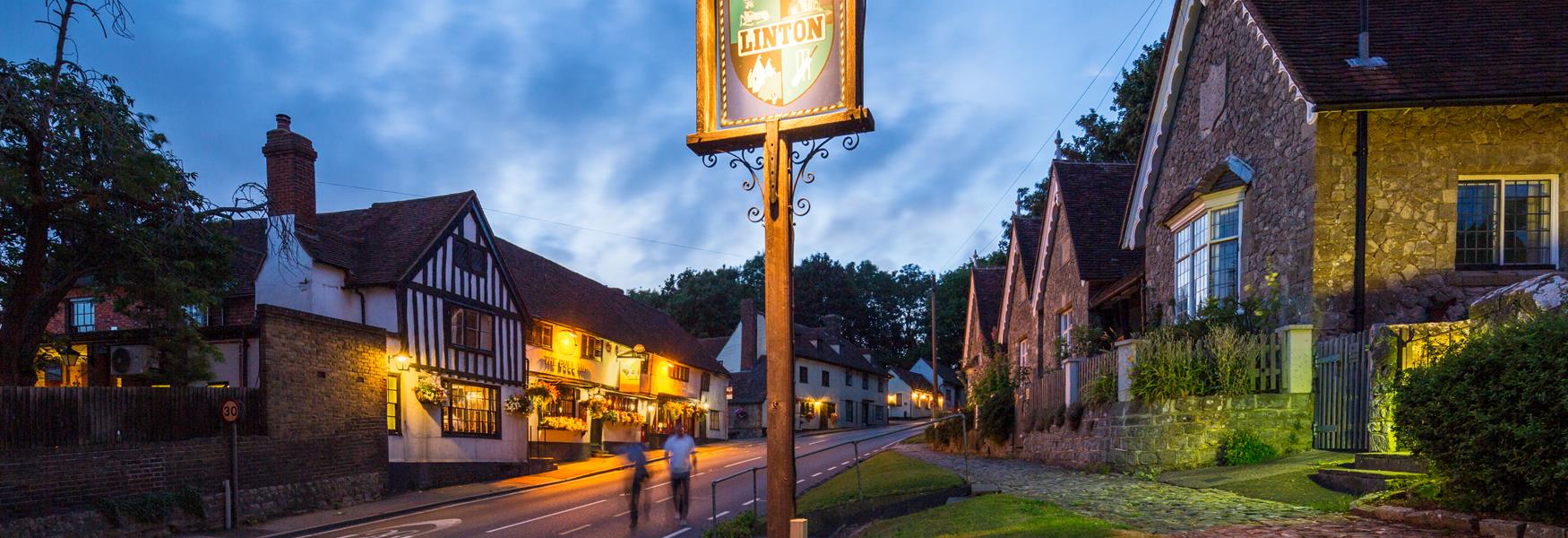To build your own Itinerary, click  to add an item to your Itinerary basket.
to add an item to your Itinerary basket.
Already saved an Itinerary?


You are here: Things to Do > Explore > Villages
There are some wonderful villages in the rural area surrounding Maidstone, all worth exploring and all with something unique and interesting to discover.
Situated in the valley of the River Medway, Aylesford is sheltered on the north and east by the chalk downs. The picturesque village centre is notable for its 14th century bridge, medieval church, Tudor Alms houses and of course Aylesford Priory.
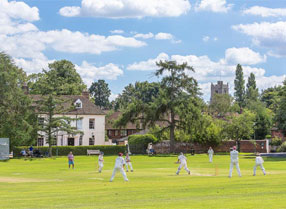 The village green cricket ground, said to be one of the oldest in Kent, has secured its place in cricketing history, as it was here that Alfred Mynn pioneered overarm bowling. The village retains its rural identity through the timber-framed houses, village shops, pubs, restaurants and Oast houses facing the green, with views of the nearby Kent Downs. Above the village stands the Ragstone Holy Cross Church with evidence of Saxon stonework and distinctive gargoyles.
The village green cricket ground, said to be one of the oldest in Kent, has secured its place in cricketing history, as it was here that Alfred Mynn pioneered overarm bowling. The village retains its rural identity through the timber-framed houses, village shops, pubs, restaurants and Oast houses facing the green, with views of the nearby Kent Downs. Above the village stands the Ragstone Holy Cross Church with evidence of Saxon stonework and distinctive gargoyles.
The village lies on a ridge overlooking the Weald of Kent. St Peter's Church dates from the 13th Century and its medieval lych gate is one of the oldest in England, but inside the Church is a modern stained glass nativity scene by local artist Graham Clarke.
The largest parish in the Canterbury diocese. This small village is an ideal of Kent with its weather boarded and redbrick houses. Boxley Abbey was once the home to the 'Rood of Grace' – a crucifix with a figure attached that was sometimes moved to express the receiving of prayers dependent on how much the monks had been paid! Now a private house it lies to the west of the village. Its 12th century barn can be seen from the footpath. Chapel Down now have large tracts of vineyards growing on the slopes of the North Downs, to the west of the village.
A charming village located on the ancient Pilgrim Way, Detling is a base for walking along the North Downs Way, and home to the Kent County Showground and Exhibition Centre.
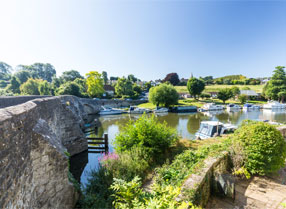 Parliamentary troops used the 14th century bridge here in 1648 to cross the River Medway and capture Maidstone from the Royalists in a fierce battle. The much quieter village of today grows fruit providing a very picturesque setting for visitors.
Parliamentary troops used the 14th century bridge here in 1648 to cross the River Medway and capture Maidstone from the Royalists in a fierce battle. The much quieter village of today grows fruit providing a very picturesque setting for visitors.
This Domesday Book village is split into two parts by the A20 and has some fine buildings and a public house. To the south of the village are the Quested Alms houses rebuilt in 1770 as a provision for the poor and supported by the parish and donations from local landowners.
.jpg) The charms of this ancient Wealden village are reflected in the neatly kept medieval cottages and High Street, which cunningly conceals a considerable shopping centre to cater for nearly every need. The restaurants and public houses provide refreshment in which to savour this unique area.
The charms of this ancient Wealden village are reflected in the neatly kept medieval cottages and High Street, which cunningly conceals a considerable shopping centre to cater for nearly every need. The restaurants and public houses provide refreshment in which to savour this unique area.
In 1382 an earthquake shook this part of Kent and damaged the church interior, creating an uneven roof that can be seen today. A long winding village with a 14th Century church and many beautiful listed buildings, which straddles the North Downs on the Pilgrims Way to provide a picturesque setting to escape every day bustle.
A nearby attraction is the Bredgar & Wormshill Light Railway - a chance to take in the delightful North Downs countryside on board a steam train. Open Easter Sunday and then the first Sunday of every month until October.
Best known for Leeds Castle, this exquisite village's winding road dips and twists past attractive cottages and timber framed houses to give a truly romantic view of times past.
.jpg) This large village is close to the North Downs and is an excellent location to start exploring the surrounding countryside. Used as a market place for many hundreds of years, the square remains the focal point of the village, flanked by medieval houses, shops, restaurants and public houses. Lenham Country Market is held on the second Sunday of every month from 9am -1pm in Lenham Market Square.
This large village is close to the North Downs and is an excellent location to start exploring the surrounding countryside. Used as a market place for many hundreds of years, the square remains the focal point of the village, flanked by medieval houses, shops, restaurants and public houses. Lenham Country Market is held on the second Sunday of every month from 9am -1pm in Lenham Market Square.
A village with a unique alpine character, as the cottages rise in terraces above the stream. The causeway in the middle of the stream crosses from one part of the village to the other. The power of the Loose stream, the purity of the spring water and the availability of Fullers Earth helped the woollen trade prosper in the 16th Century. The village public house and restaurant borders Loose Stream, providing a picturesque setting.
The village was part of a Royal Hundred with its own courthouse that is located in the centre of the village – recalling the times when it was exempt from the jurisdiction of the county sheriff. The old stocks are now in the south porch of the 13th Century church of St Michael and All Angels.
Famed for its late medieval timber-framed houses such as Stoneacre, a small 15th Century Yeoman's house. The writer William Stevens who called himself 'Nobody' founder of the society of 'Nobody's Friends' is buried in the churchyard. The village enjoys an elevated position southeast of Maidstone and overlooks spectacular views of the countryside.
Nestling in the Weald of Kent on a Roman road, the large village of Staplehurst is surrounded by fields of hops, corn, vine and wheat. Charles Dickens was involved in a serious railway accident here in 1865 when returning from Paris with his mistress and her mother. The Martyrs' Memorial commemorates the death of those burned during the Marian persecution (protestant martyrs). Staplehurst is also home of Hush Heath Winery and Iden Croft Herb Garden.
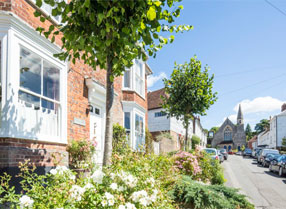 The ruins of Sutton Valence castle lie on the southern slope of the hill, the home of William de Valence half-brother to Henry III who granted William the area of Sutton and hence its title. The village has beautiful views over the countryside and some welcoming inns.
The ruins of Sutton Valence castle lie on the southern slope of the hill, the home of William de Valence half-brother to Henry III who granted William the area of Sutton and hence its title. The village has beautiful views over the countryside and some welcoming inns.
Mentioned in the Domesday Book, this small village has a fascinating Norman history. The ruins of the motte and bailey castle can still be seen within the White Horse Wood. The parish church of St Mary the Virgin enjoys a beautiful setting and includes some early Norman features. The North Downs Way National Trail skirts the upper reaches of the village, with outstanding views across the Kentish Weald.
A small Wealden village with a fascinating Norman history and one of the most interesting churches in the area. Earlier this century the remains of hundreds of human bones were discovered at Ulcombe church and it is reported that a loud crash of thunder and a flash of lightning followed by heavy rain broke at the moment when the shovel hit the first bone.
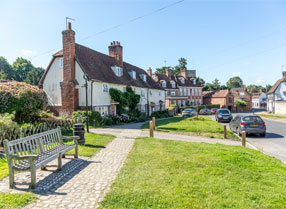 Three rivers - the Beult, Teise and Medway - meet at Yalding, and are crossed here by three medieval bridges. It is one of the largest hop growing parishes in England and is surrounded by orchards and oast houses. The Lees on the banks of the River Medway is much favoured for a relaxing afternoon.
Three rivers - the Beult, Teise and Medway - meet at Yalding, and are crossed here by three medieval bridges. It is one of the largest hop growing parishes in England and is surrounded by orchards and oast houses. The Lees on the banks of the River Medway is much favoured for a relaxing afternoon.
The church has an unusual spire, and the area around the church is worth visiting, with the old Town Bridge and its long and narrow stone span providing a picturesque walk over the river.
© Visit Maidstone 2025. All Rights Reserved



